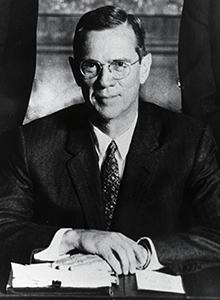
Oliver S. Powell
- President, Federal Reserve Bank of Minneapolis, 1952 – 1957
- Governor, Board of Governors, 1949 – 1952
Oliver S. Powell was a member of the Board of Governors of the Federal Reserve System from September 1, 1950, until June 30, 1952. He then served as president of the Federal Reserve Bank of Minneapolis from July 7, 1952, to April 1, 1957.
Powell was born in 1896 in White Rock, South Dakota. He moved with his family to Weyburn, Saskatchewan, as a teenager, and it was said he excelled in hockey. He graduated from the University of Minnesota in 1917 with a bachelor's degree in economics. Prior to joining the US Navy in 1918, Powell spent six months in Petrograd (now St. Petersburg), Russia, working for National City Bank of New York. He witnessed firsthand the chaos of the Russian Revolution.
Powell originally came to the Minneapolis Fed in 1920 and was head of the Reserve Bank's Research department by 1927. He moved into the position of first vice president in November 1936. Powell's career at the Minneapolis Fed was interrupted in 1949 when President Harry Truman appointed him to fill an unexpired term on the Board of Governors of the Federal Reserve System. He served on the Board of Governors until June 30, 1952, when he returned to Minneapolis as president of the Reserve Bank.
While at the Board, Powell gave a speech to the Conference on Bank and Public Relations in April 1951 as chairman of the National Voluntary Credit Restraint Committee, a group organized by commercial bankers in which the Fed participated. His remarks would be timely today: "What we are trying to achieve is this—to get 'horse sense' back into the lending field and to get bankers to avoid things which they know are not sound. Excesses (in lending) have a kickback. People are not going to thank a banker for lending them money if he lends them too much. A banker never wins by sacrificing good judgment to make a loan."1
Powell was a teacher, writer, and, above all, a proponent of the Federal Reserve System, producing publications and films that helped explain the work of the Fed and make it seem less arcane. He helped develop the Minneapolis Fed's "Short Course in Central Banking" and seminars for instructors in money and banking, setting a tone of transparency that has long been a mark of the Minneapolis Fed.
Powell resigned for health reasons in 1957 but continued to be active in the banking community, serving as an adviser to the Bank of Korea for two years.
Powell was a member of two fraternities and the Minneapolis Club. Powell died in 1963 in Edina, Minnesota.
Written by the Federal Reserve Bank of Minneapolis.See disclaimer and update policy.





 X
X  facebook
facebook
 email
email